St. Francis Dam Disaster
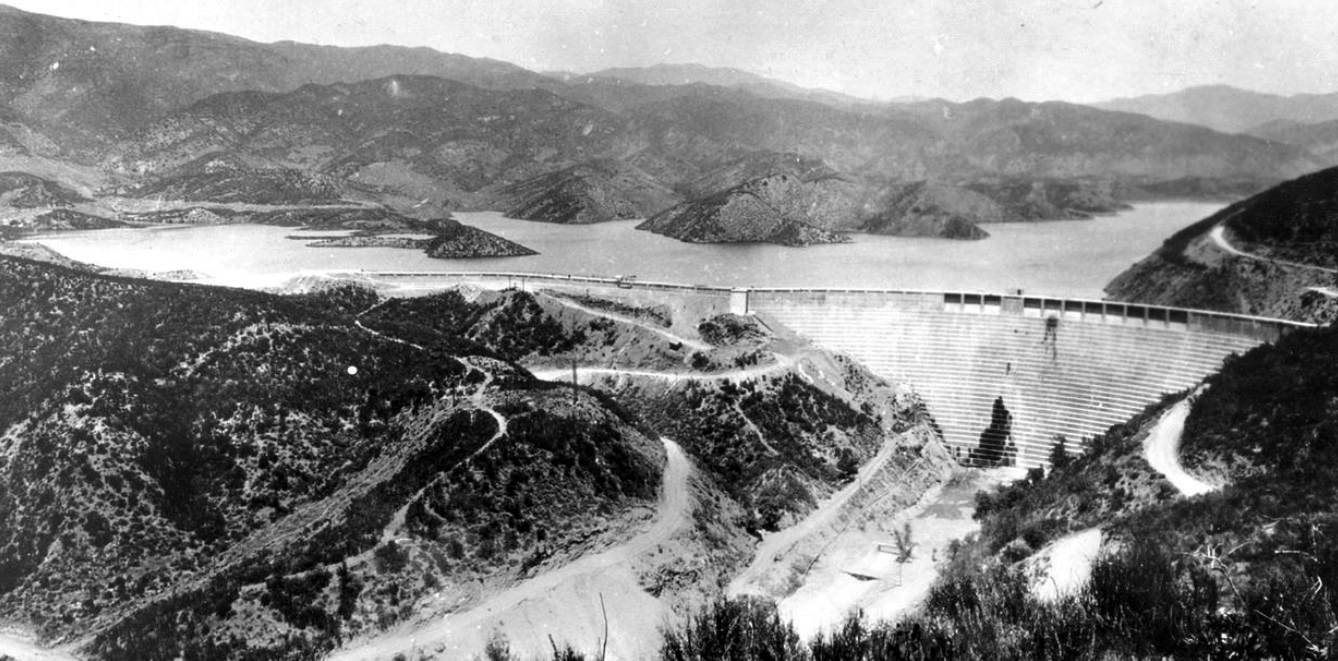 |
|
| (1928)*^* - Panoramic view showing the St. Francis Dam with large reservoir behind it. The dam was located in the San Francisquito Canyon, about 5 miles northeast of what is now Magic Mountain, California. |
Historical Notes Construction of the St. Francis Dam began on March 9th, 1925. It was completed a year later, almost to the day. The colossal concrete structure was 205 feet high, 1225 feet long on its crest, 150 feet long at its base, and 160 feet thick at the stream level. The St. Francis Dam failed catastrophically upon being filled for the first time, near midnight on March 12, 1928. Over 450 people perished as the flooding waters raced through the San Francisquito and Santa Clara River valleys and continued on its 54 mile course to the ocean. It ranks as one of worst American civil engineering failures in the 20th Century. |
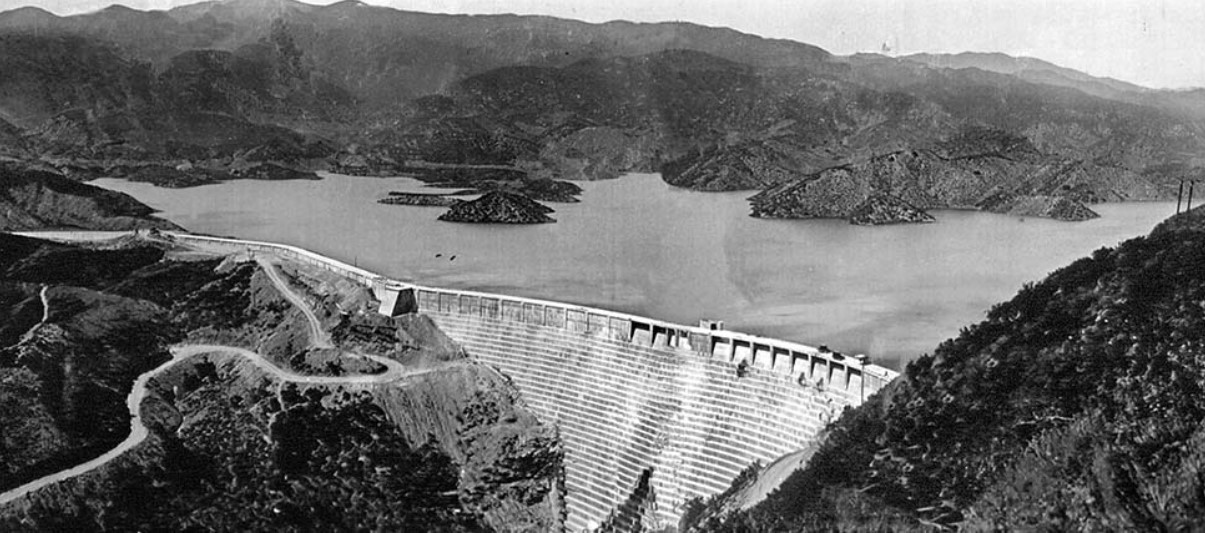 |
|
| (1928)^^* – View showing the St. Francis Dam and water reservoir behind it shortly before the dam's collapse. |
Historical Notes It would take two years after its completion before the new lake behind it would be filled. The new reservoir would provide 38,000 acre-feet of storage from water flowing on the Los Angeles Aqueduct. |
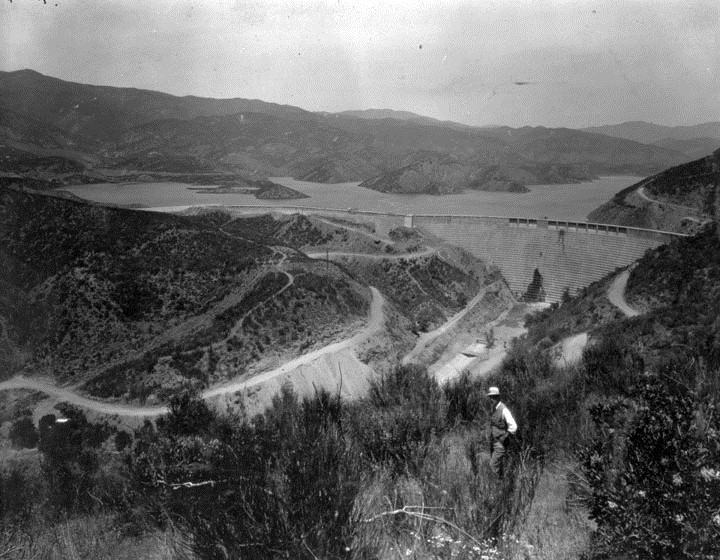 |
|
| (1928)* - St. Francis Dam as seen from the hillside. Note the man with the hat in the foreground. |
Historical Notes The concrete-arched gravity dam was built by the City of Los Angeles Bureau of Water Works and Supply (now DWP) under the supervision of its chief engineer, William Mulholland. |
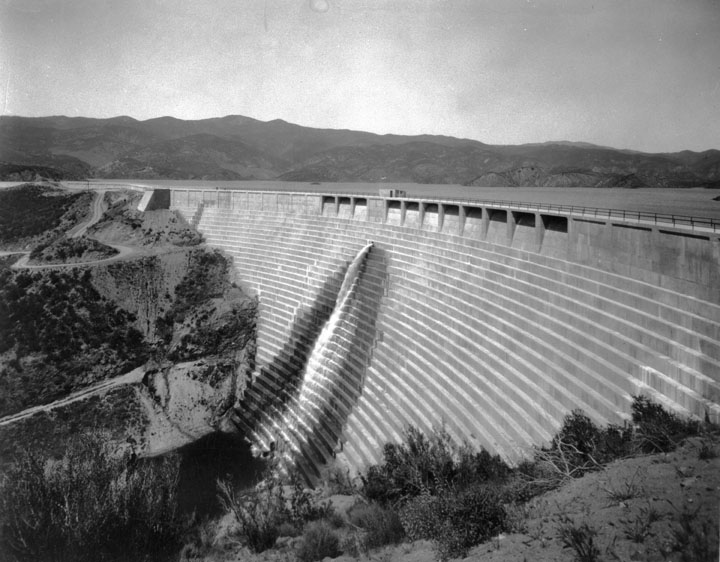 |
|
| (1928)* - Close-up view of the St. Francis Dam shortly before being filled to capacity. |
Historical Notes The St. Francis Dam was given an anglicized version of the name of the creek bed on which it rested (San Francisquito). |
St. Francis Dam Construction
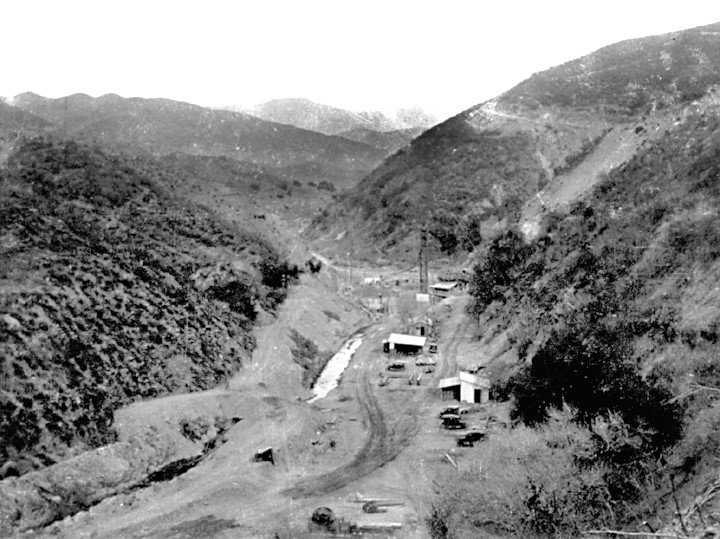 |
|
| (1925)*^* - Preliminary work begins at the base of San Francisquito Canyon. |
Historical Notes On March 9th, 1925, preliminary work began in preparing for the construction on the 600-foot-long, 175-foot-high St. Francis Dam. |
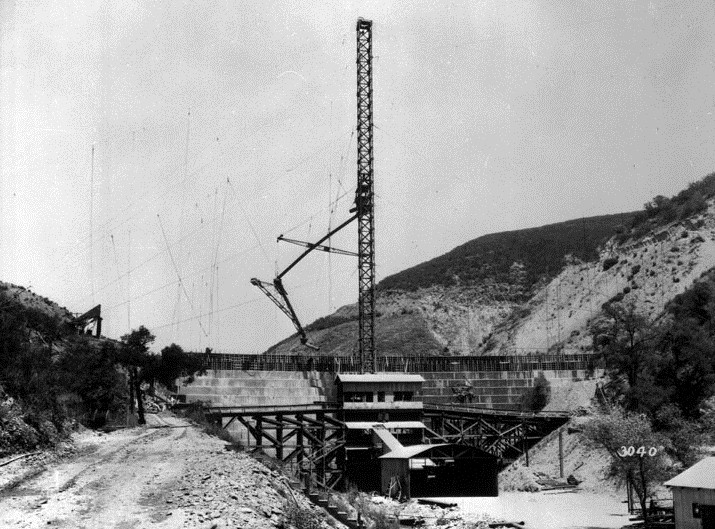 |
|
| (1925)* - Construction site of the St. Francis Dam showing tower, concrete mixing shed and runway. |
Historical Notes The dam was designed to be 175 feet tall and to hold back a reservoir of 30,000 acre feet. However, immediately after construction began in 1925, Mulholland decided to raise the dam 10 feet and increase the capacity of the reservoir to 32,000 acre feet. Since little construction had been completed, some minor changes were made in the design to accommodate the change.* |
 |
|
| (1925)**^ - View showing the construction of a new "wing dyke" to accomodate mid-construction design changes. |
Historical Notes In July 1925, when the dam was about halfway completed, Mulholland again decided to raise the dam another 10 feet to a total height of 195 feet. A “wing dyke” had to be constructed on the western side of the dam to keep water from spilling over a low ridge when the reservoir filled.* |
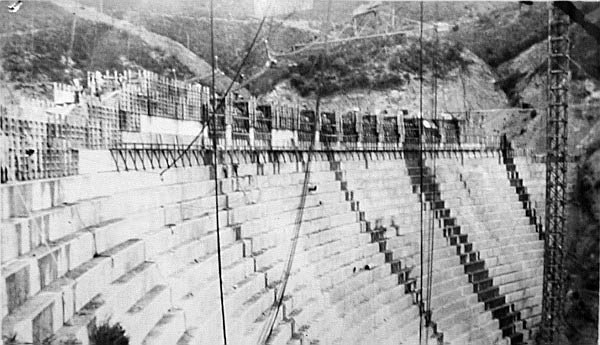 |
|
| (1925)**^ - The St. Francis Dam nearing completion. A mid-construction design change increased the total height of the dam to 195 feet. |
Historical Notes Gravity dams like the St. Francis Dam use their weight to resist the water pressure exerted on them. The St. Francis Dam was increased in height from the designed 175 feet to 195 feet at completion, without any substantial widening of the dam’s base. Such changes would not occur with modern engineering practices, but little was said about the changes in 1925.* |
St. Francis Reservoir is Filled
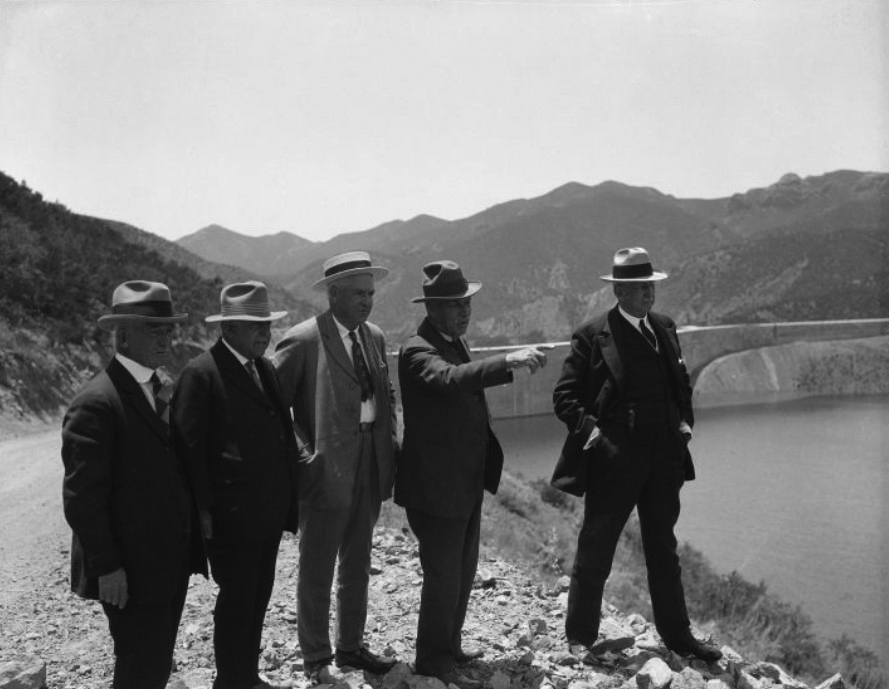 |
|
| (1928)^^^ - William Mulholland, Superintendent of the Bureau of Water Works and Supply of Los Angeles, pointing towards something in the distance. Mulholland is with 4 other men on the east bank of the St. Francis Reservoir with the top of the St. Francis Dam visible behind them. |
Historical Notes From left to right can be seen Fred Fischer, R. del Valle, ???, William Mulholland and John R. Haynes. |
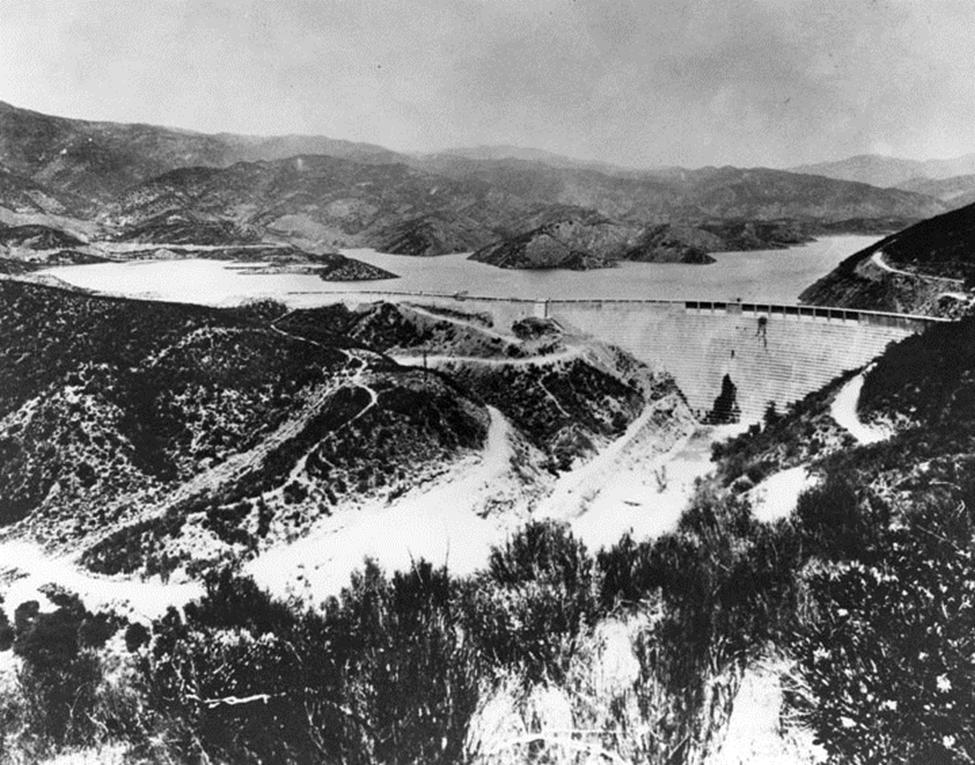 |
|
| (1928) * - Aerial view of St. Francis Dam close to the time of its failure. The lake behind the dam continues to be filled. It took two years for the reservoir behind the dam to completely fill. Some water stains can be seen on the wall. |
 |
|
| (1928)*# - View showing the St. Francis Dam with the lake behind it now filled to capacity. The small island at center-left is now almost completed submerged (compare to previous photo). |
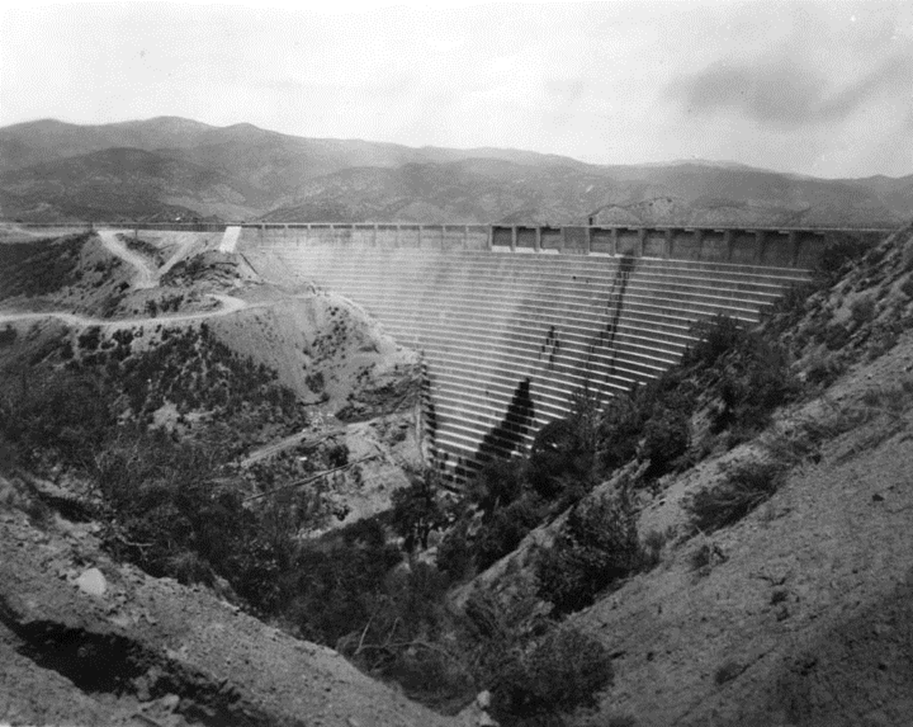 |
|
| (1928)* - This pre-failure photograph shows the exterior of the dam and surrounding countryside. This was taken just before the break. |
Catastrophic Failure
 |
|
| (1928)**^ - View of the St. Francis Dam just hours after its catastrophic failure (11:57 p.m., March 12, 1928). It took only 70 minutes for entire 12.4 billion gallons of water to drain out of the man-made reservoir supported by the dam. |
Historical Notes The dam crumbled at 11:57 pm on March 12, 1928, scarcely 12 hours after Mulholland had inspected it. There were no surviving eyewitnesses to the failure, but one man on the road about a half-mile away from the dam recalls feeling a strange shaking of the ground and the sound of “crashing, falling blocks.” The shaking he felt was no earthquake but rather the tumble of incredibly heavy pieces of concrete that were falling off the dam.^* |
 |
|
| (1928)** - View showing the aftermath of the St. Francis Dam collapse. The water line can be seen on the hills in the upper-right. |
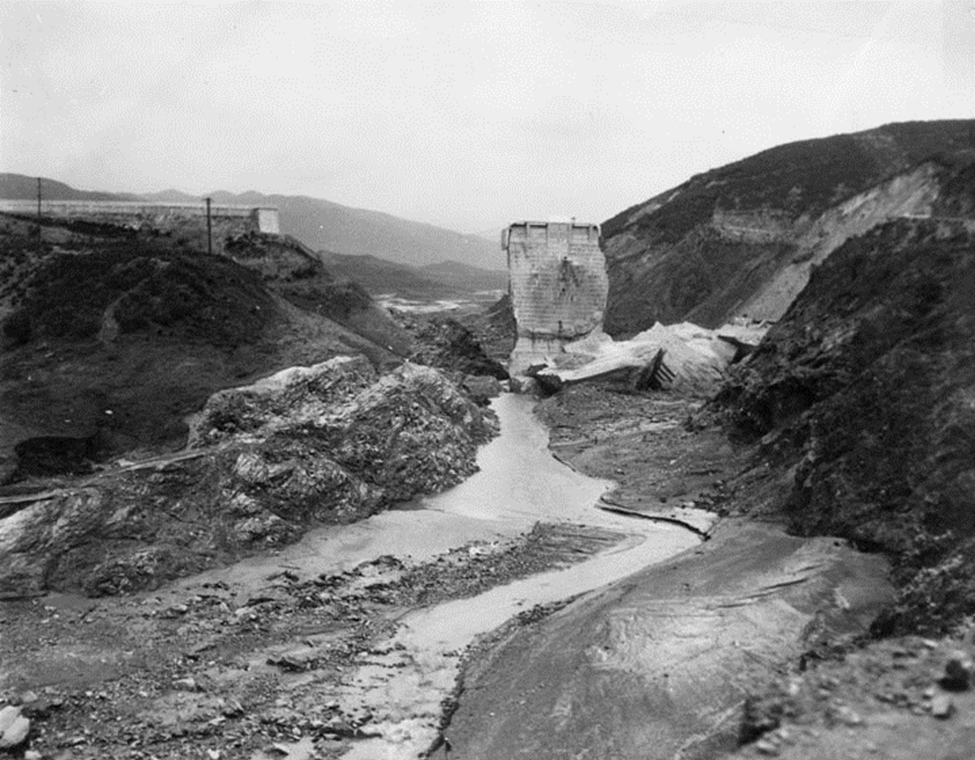 |
|
| (1928)* - This post-failure photograph shows the stream of remaining water coming down from the dam. Only one center piece of the wall remains standing, both ends having been washed away. |
 |
|
| (1928)^^* – View of the last remaining standing section with crumbled sections at base, water still streaming downhill. |
St. Francis Dam fails at 11:57 p.m. on March 12, 1928
The first community struck after the dam's demise was Castaic, which was said to have been "swept clean as a pool table." Minutes later, a power company camp in the river valley was washed away leaving 84 people dead Portions of the towns of Piru, Fillmore, Santa Paula and Saticoy were completely demolished. Nearly 500 people were killed in the flood.
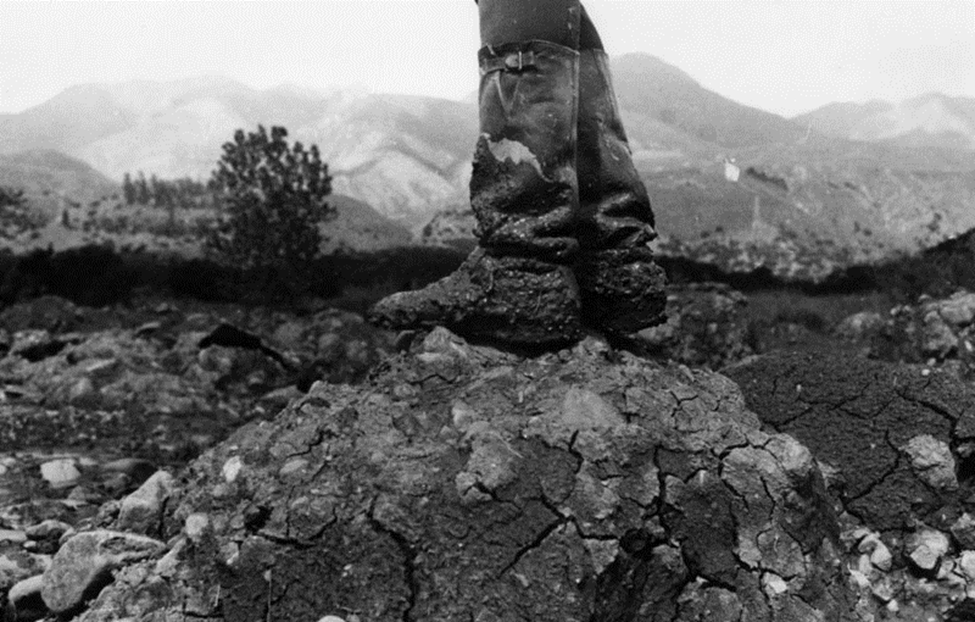 |
(1928)* - A man in rubber boots stands atop a mound of rocks and mud formed as a result of the failure of the St. Francis Dam in 1928. The dam collapsed in March of 1928 at 11:57 p.m., sending 12 billion gallons of water rushing down the Santa Clara River Valley.
|
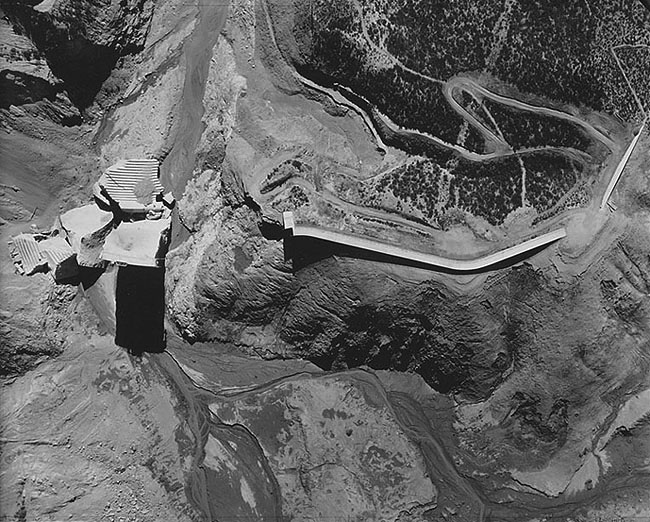 |
|
| (1928)*^ - Aerial view from directly above the collapsed dam. |
 |
|
| (1928)^^* - Aerial view showing the aftermath of the dam's destruction. Only the singular center section of the dam remains upright. The hillside displays signs of a major landslide. |
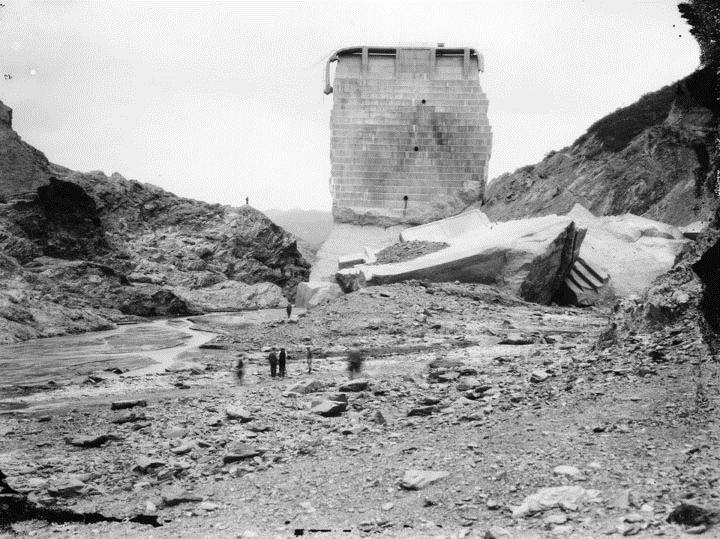 |
|
| (1928)* - Ground view showing several men looking very small as they stand in the area below the failed dam. One large chunk of dam remains standing while another lays on the ground below it. |
Historical Notes The center section of the dam, later nicknamed "The Tombstone", remained standing; the rest broke into numerous smaller and several large pieces most of which were washed downstream. The largest, weighing 10,000 tons, was found about three-quarters of a mile down from the dam site.*^ |
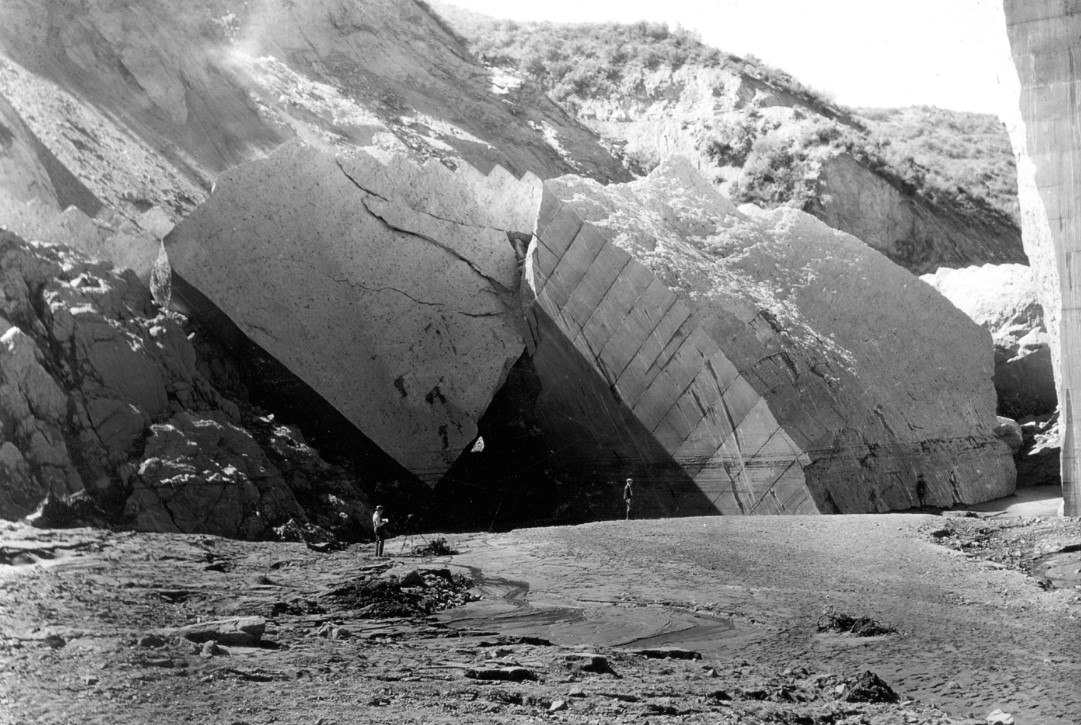 |
|
| (1928)*^^ - Several men stand at the base of the collapsed dam's remains. |
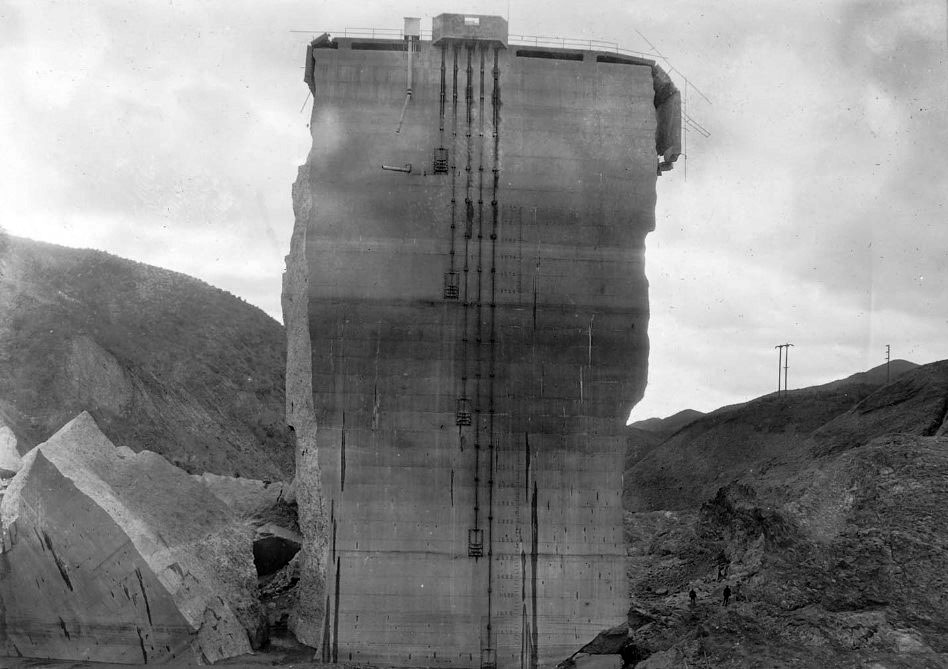 |
|
| (1928)^*^ – Close-up view of the last remaining standing section of the St. Francis Dam, also referred to as “Tombstone”. Three men are seen climbing the debris at its base. |
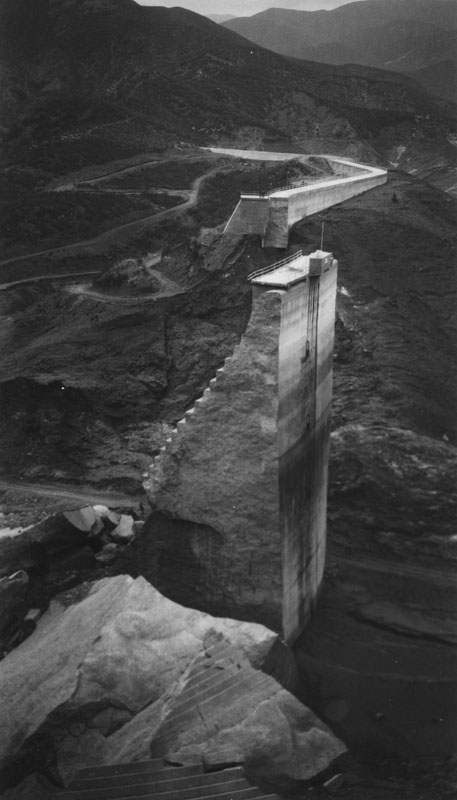 |
Side view of a massive concrete slab nicknamed "The Tombstone". This is the center section, and the only remaining portion, of the St. Francis Dam after its disastrous collapse in March 1928. Several large concrete blocks can be seen scattered throughout the area, and a few people can be seen along the road at the base of the mountain as well as atop a remaining portion of the bridge in the far distance.
|
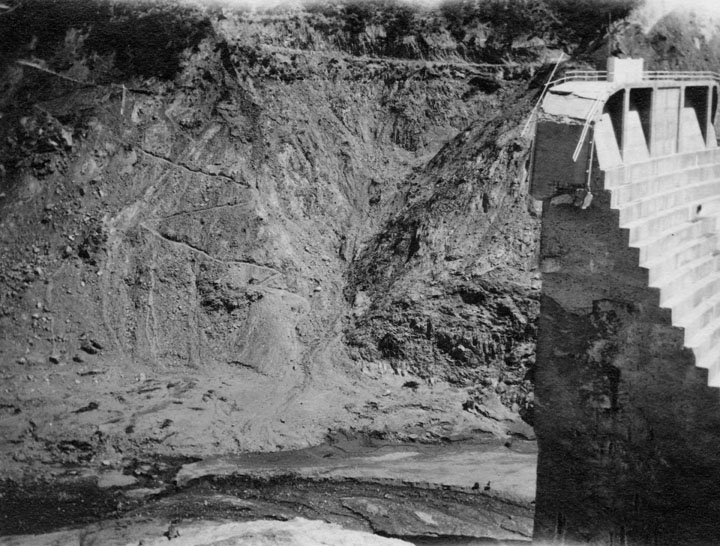 |
|
| (1928)* - Photo shows edge of the major piece still standing, and to the left of it a little of the water still left in the area. At the top left is a road closed by land slippage. |
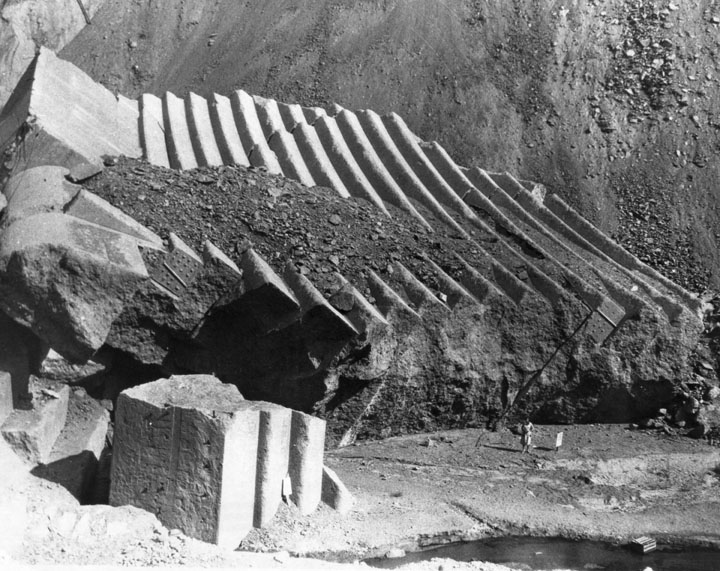 |
|
| (1928)* - A woman can be seen standing on the ground below some of the huge pieces of the failed dam which were washed down by the 100 foot high wall of water which raced towards Ventura. |
 |
|
| (1928)* - Sightseers climb large chunks of concrete, St. Francis Dam. |
Historical Notes A few months after the dam's collapse, 18-year-old Lercy Parker fell to his death from the standing section after his friend, in playing a joke, had thrown a dead rattlesnake at him.*^ |
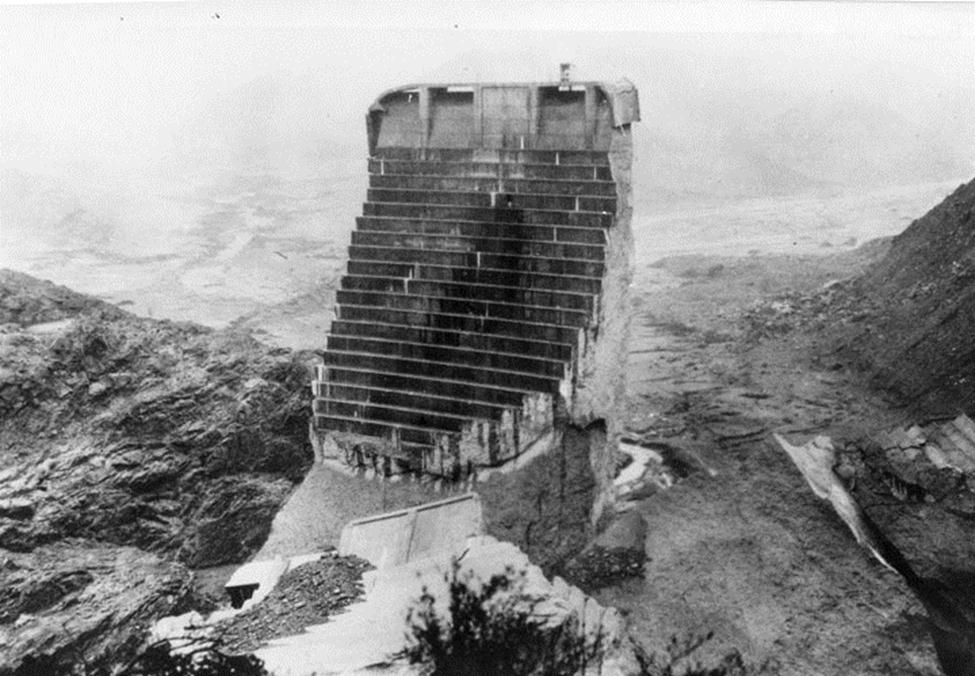 |
|
| (1928)* - Aerial view of the remaining, standing piece of the failed dam. Water soaked land and a small stream can be seen below and behind it. |
Historical Notes In May 1929, the upright section was toppled with dynamite and the remaining blocks were demolished with bulldozers and jackhammers to discourage sightseers and souvenir hunters from exploring the ruins.*^ |
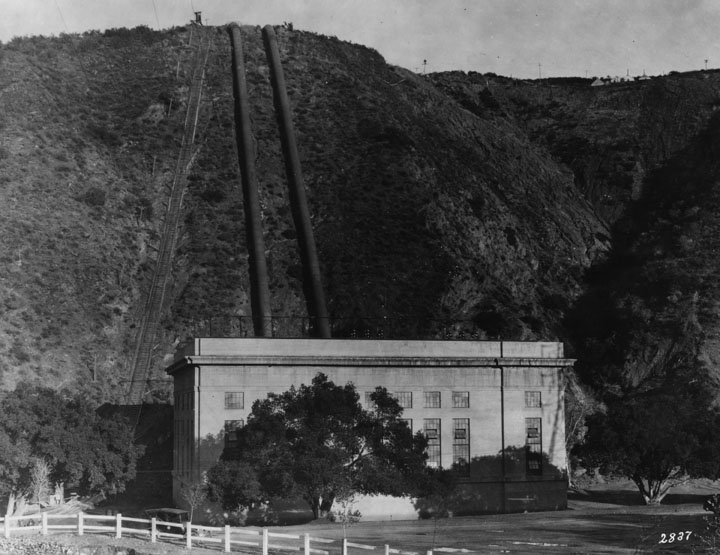 |
|
| (1920)* - This pre-failure photograph shows the exterior of the San Francisquito Power Plant No. 2 at the base of a hill with pipes (penstocks) running up the hill. The plant was directly in the path of the flooding water. |
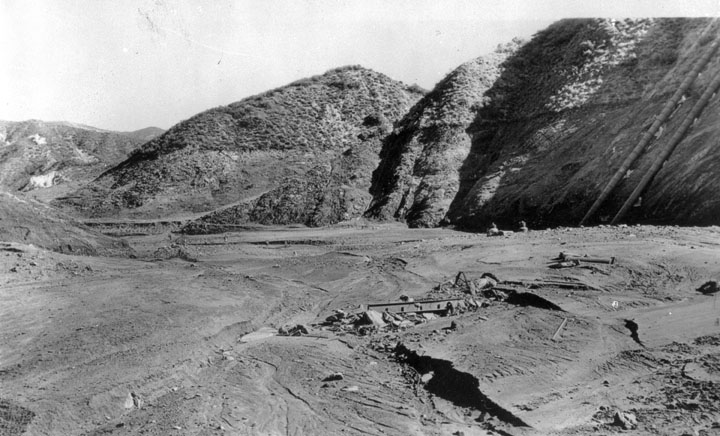 |
|
| (1928)* - The ruins of the San Francisquito Power Plant No. 2 are clearly visible from the canyon road above. The plant's penstocks can also be seen in the upper right. |
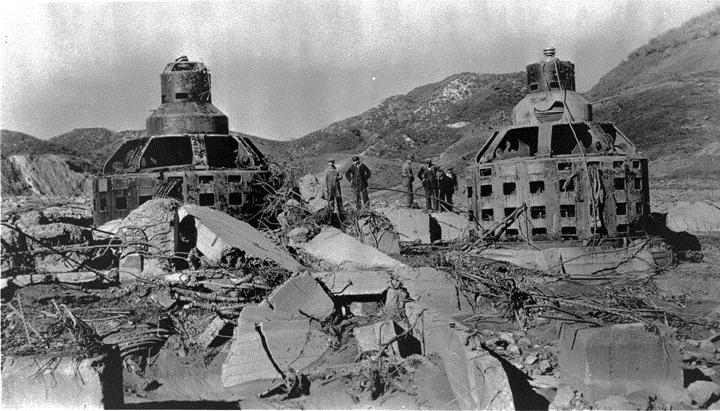 |
|
| (1928)* - Generators stand in the rubble of Power Plant No. 2 which stood just 5 miles north of Newhall. |
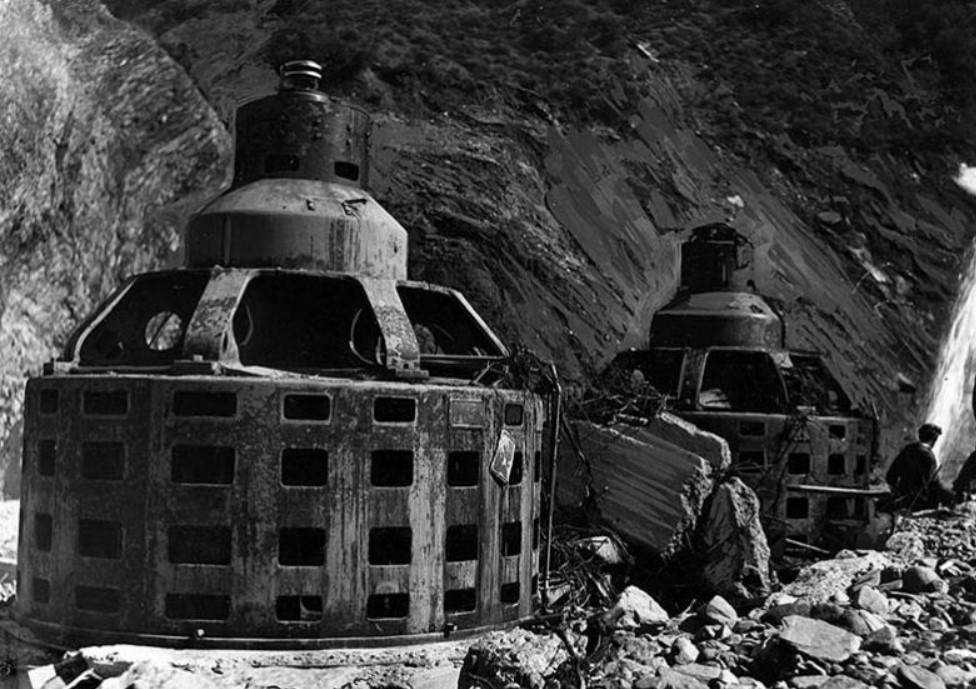 |
|
| (1928)^^* – Close-up view showing the turbine-generator housings - all that is left of Power House No. 2. LA Times Photo: March 15, 1928 |
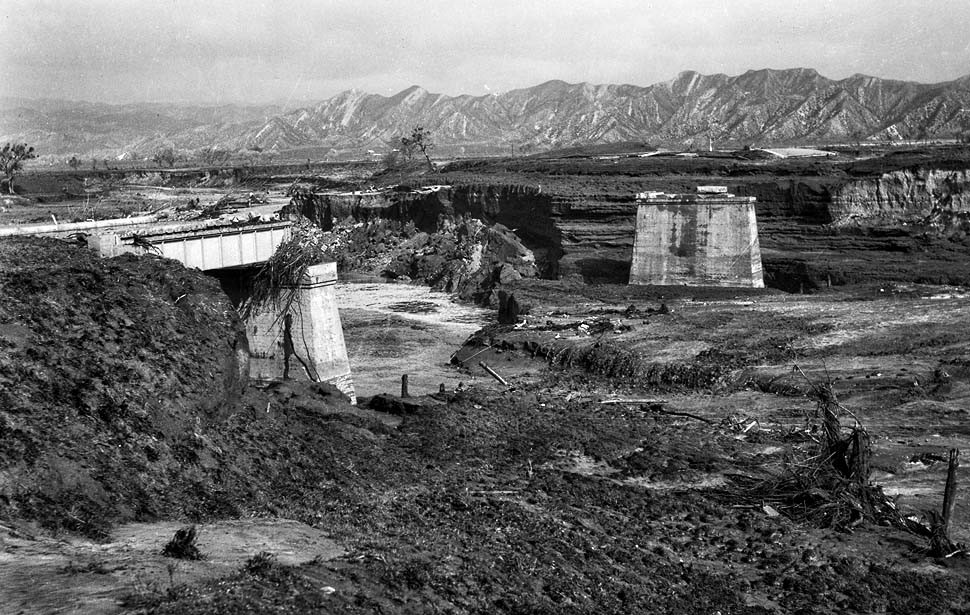 |
|
| (1928)^^* – View of Main Highway Bridge one and one-half miles from Castaic. Only the supports survived the flood waters following the St. Francis Dam collapse. |
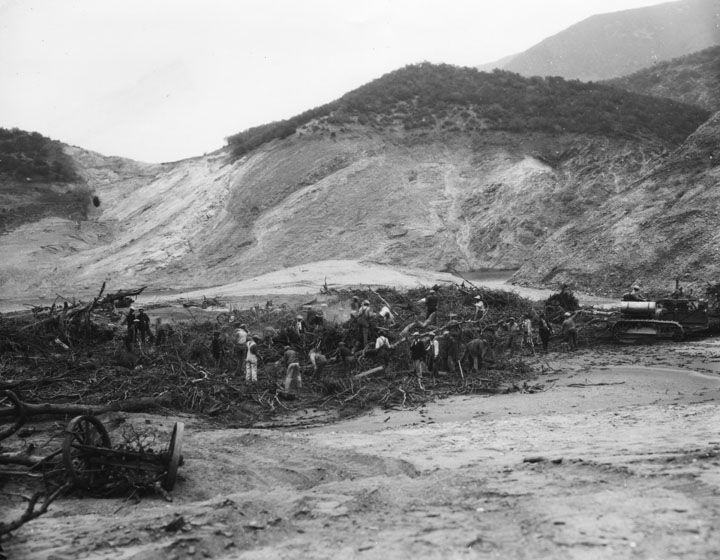 |
|
| (1928)* - This post-failure photograph shows men working in a field of broken trees, wagons and other debris attempting to clear it away. A caterpillar tractor is visible on the right side. |
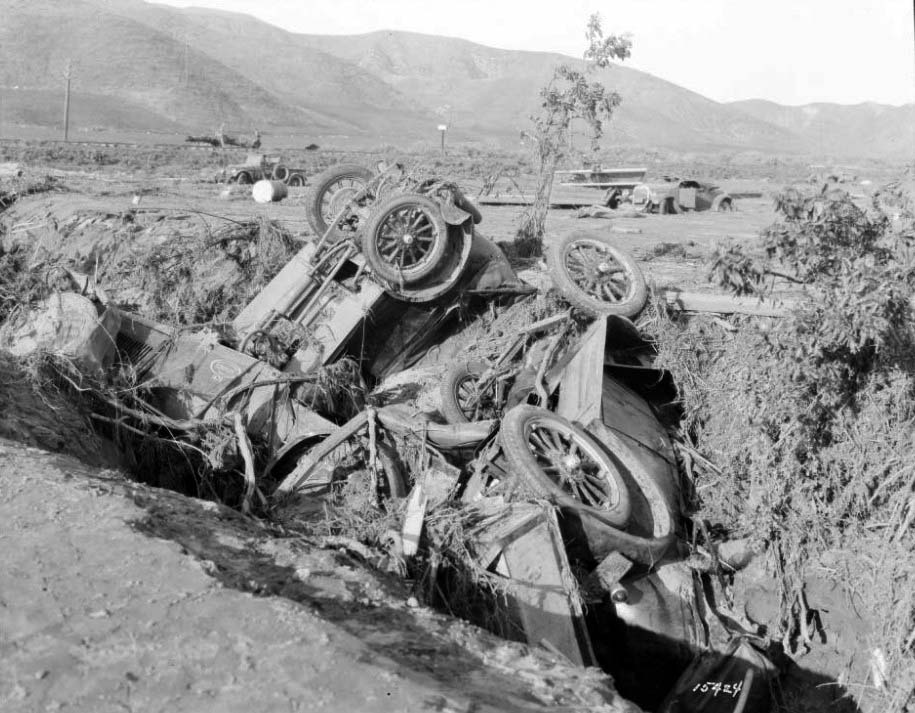 |
|
| (1928)^** - Twisted company auto wreckage marks the site of the Southern California Edison Kemp Camp which was destroyed in the flood. |
Historical Notes Just past the Ventura County line along the Santa Clara River was a railroad siding called Kemp. There, a group of 150 workers for the Edison company were fast asleep in a tent camp used while they were building a transmission line. Night watchman Ed Locke watched in horror as the huge flood of water approached the camp. He ran through the camp, waking up as many people as possible. Locke, a true hero of the disaster, perished that night, along with 84 of the workers as the flood hit a geologic outcropping called Blue Cut, which created a whirlpool effect that uprooted the tents. Most of the survivors had their tents zipped up, which allowed them to float on the whirlpool.*^* |
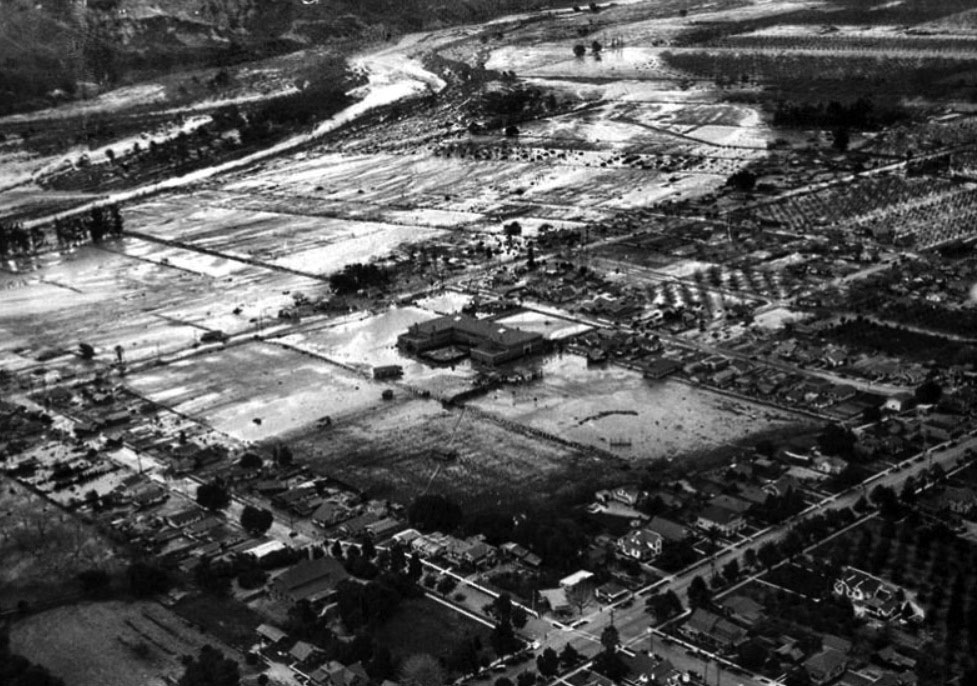 |
|
| (1928)^^* - Aerial photo of the City of Santa Paula following the collapse of the St. Francis Dam. This photo was published on page one of the March 14, 1928 LA Times. |
Historical Notes There were other heroes to recognize at Santa Paula. Louise Gipe, a night telephone operator at Santa Paula, received a call from the Pacific Long Distance telephone operator at 1:30 a.m., warning of the flood headed her way. Ignoring the peril to her own life, she stayed at her post, notifying California Highway Patrolman Thornton Edwards and calling residents in the low-lying areas of Santa Paula to warn them about the impending flood. Edwards would become known as the "Paul Revere of the St. Francis Flood" as he raced wildly from door to door warning residents of Santa Paula. While Edwards spread the alarm through Santa Paula, deputy sheriff Eddie Hearne raced up the Santa Clara River Valley toward the flood with his siren blaring to warn residents. He made it as far as Fillmore, where he met the flood waters and had to stop his wild ride.*^* There's a monument to their deeds in downtown Santa Paula, a sculpture called "The Watchers" that depicts the two motorcycle policemen who rode through town spreading the word. |
.jpg) |
|
| (1928)^^* - Remains of homes in Santa Paula following the collapse of St. Francis Dam. LA Times Photo: March 14, 1928 |
 |
|
| (1928)* - People examine the damaged road and washed away railroad track, caused by excess water flowing down the Santa Clara River after the failure of the St. Francis Dam. |
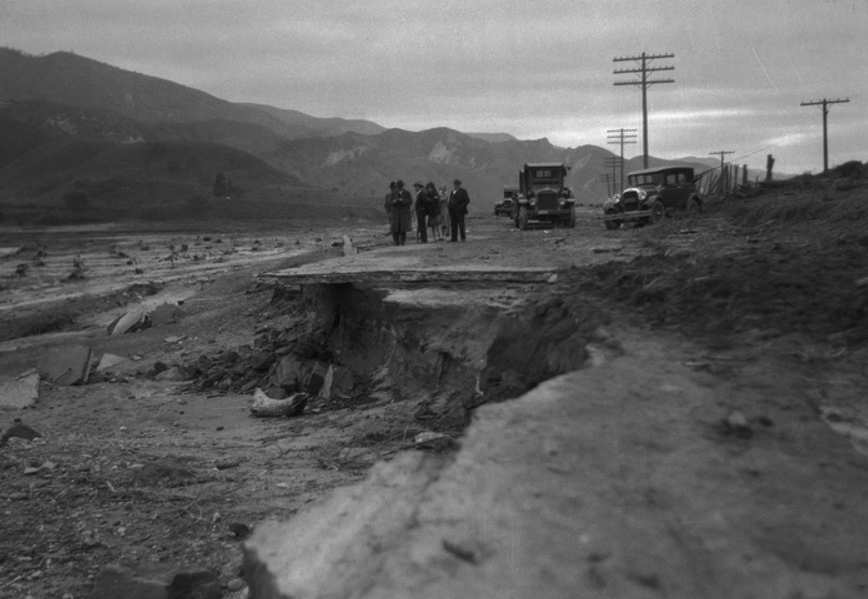 |
|
| (1928)^^^ - Officials on the edge of the wide path of the flood that followed the failure of the St. Francis Dam. |
 |
|
| Map showing the St. Francis Dam flood path. Ventura County Star/Steve Greenberg** |
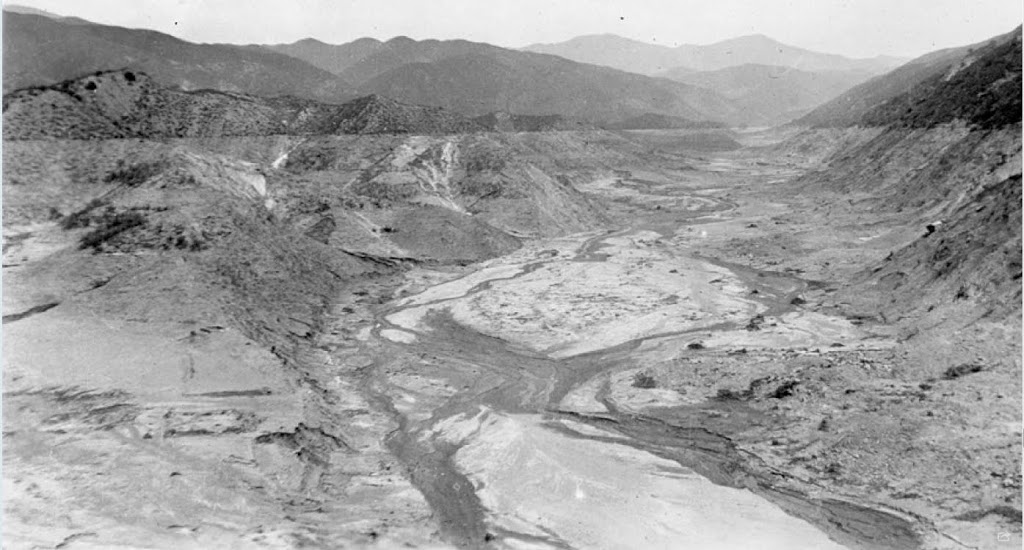 |
|
| (1928)^^ - St. Francis reservoir a day or two later after all 12.4 billion gallons had drained out of it less than 70 minutes. The water line can be seen on the face of the mountains. |
Historical Notes The disaster was primarily caused by the ancient landslide material on which the eastern abutment of the dam was built, which would have been impossible for the geologists of the 1920s to detect. Two of the world's leading geologists at the time, John C. Branner of Stanford University and Carl E. Grunsky, had found no fault with the San Francisquito rock. Therefore, an inquest jury determined responsibility for the disaster lay with the governmental organizations which oversaw the dam's construction and the dam's designer and engineer, Mulholland, but cleared Mulholland of any charges, since neither he nor anyone else at the time could have known of the instability of the rock formations on which the dam was built. The hearings also recommended that "the construction and operation of a great dam should never be left to the sole judgment of one man, no matter how eminent."*^ |
Follow-Up Analysis J. David Rogers, a professor of geological engineering at Missouri University of Science and Technology, published a comprehensive account of the dam's failure. The dam's failure can be attributed to three major factors: the instability of the ancient landslide material on which the dam was built, the failure to compensate for the additional height added to the dam's design, and the design and construction being overseen by only one person.*^ |
Click HERE to see a slide presentation of Roger's report.^ |
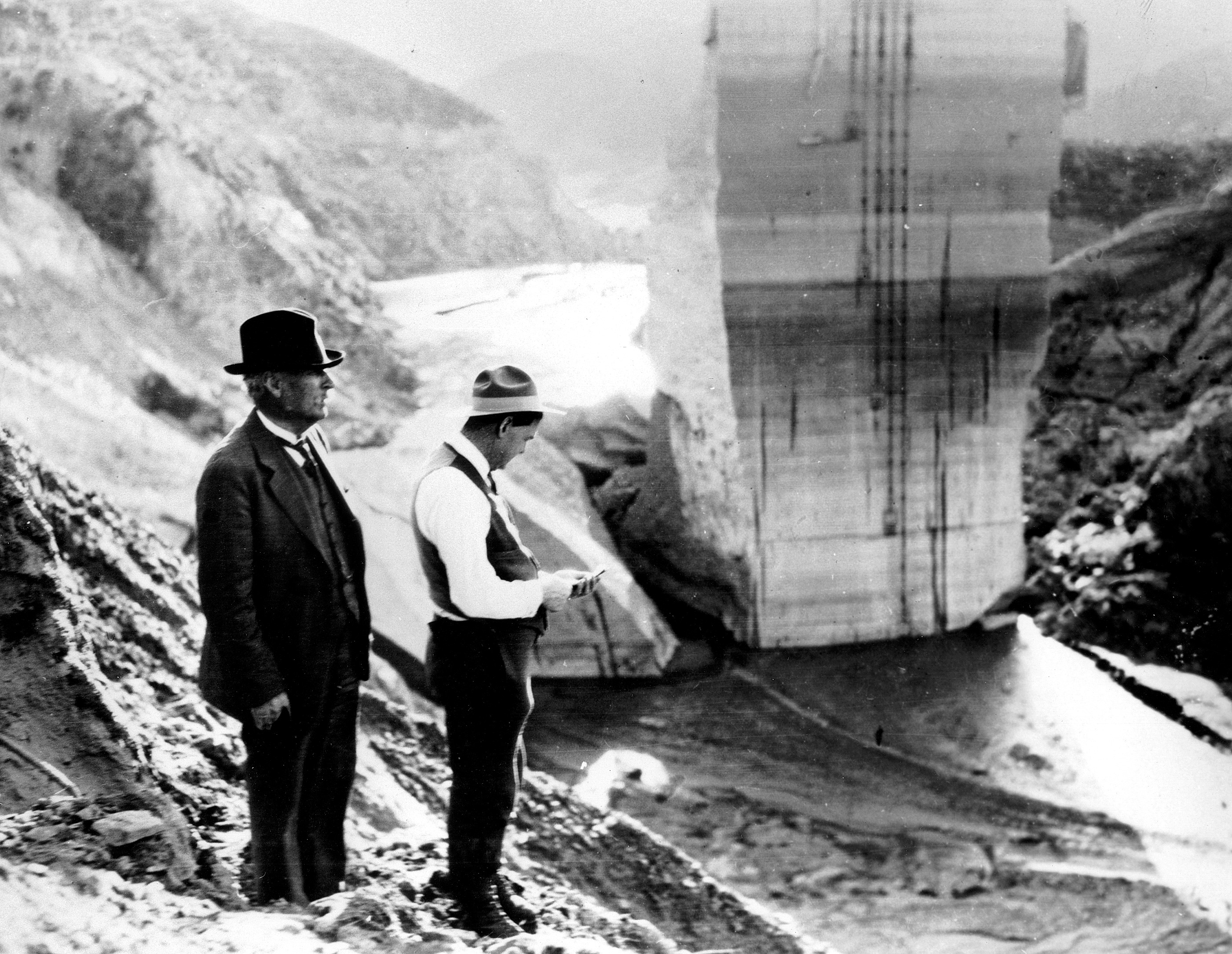 |
|
| (1928) – William Mulholland and H. Van Norman stand on the hillside overlooking St. Francis Dam ruins shortly after it failed. |
Aftermath Despite some reports absolving Mulholland of culpability, the collapse ushered in a public distrust of all prior Mulholland projects. The aqueduct was re-evaluated, reservoirs double-checked, and his prior dams were re-enforced with more earth. The famed Mulholland Dam in Hollywood, which was similar in design to the St. Francis Dam, was also evaluated and re-enforced.**^ Click HERE to see more in Early Views of the Mulholland Dam and Hollywood Reservoir. |
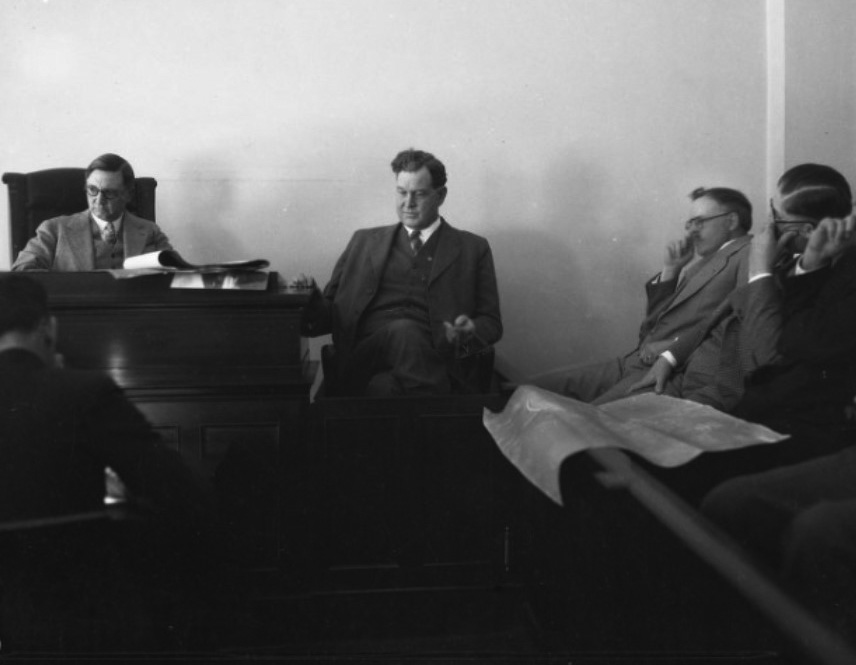 |
|
| (1928)^^^ - Coroner Frank Nance and engineer H. A. Van Norman at the Coroner's Inquest following the failure of the Saint Francis Dam, Los Angeles. |
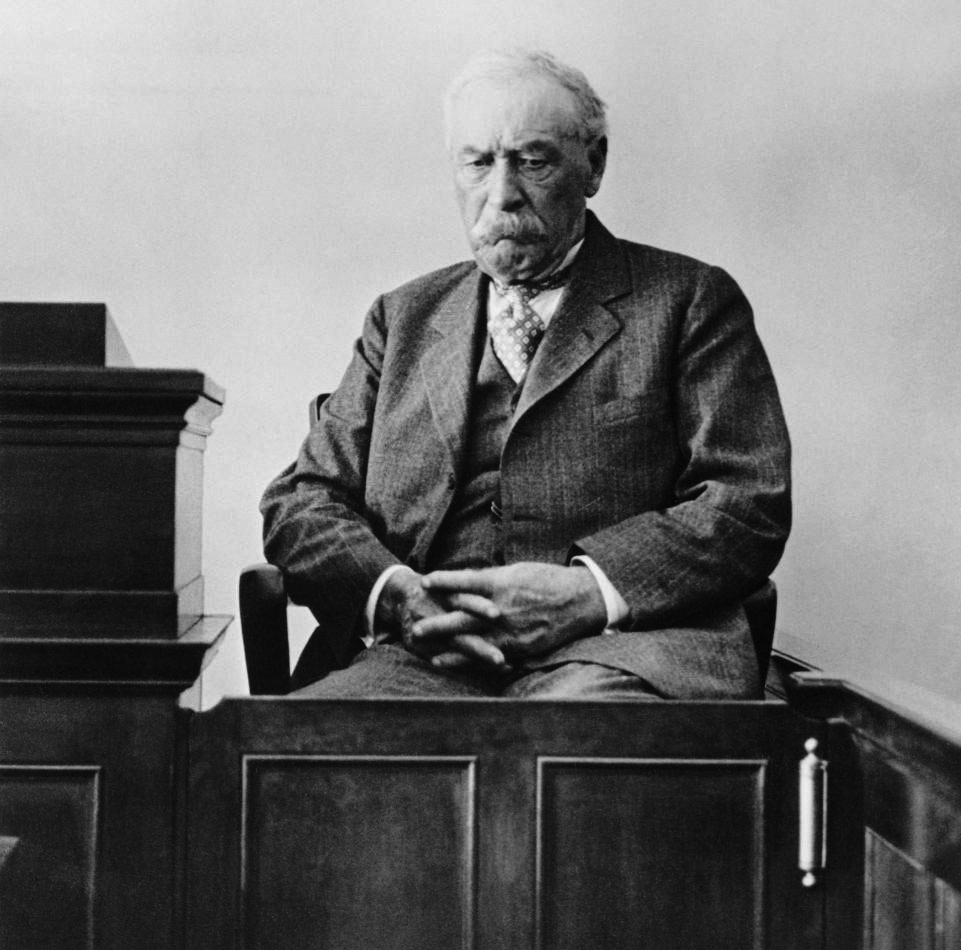 |
(1928)#* - View showing William Mulholland testifying on the witness stand on March 26, 1928 in Los Angeles, at the coroner's inquest.
|
Aftermath Mulholland took responsibility in a way that no public figure would today. During the official inquest, he claimed the mistake as entirely his own. “The only ones I envy about this thing are the ones who are dead,” the crestfallen chief announced. He retired from the Bureau of Water Works and Supply in March 1929. His assistant, Harvey Van Norman, succeeded him as Chief Engineer and General Manager. Mulholland was retained as Chief Consulting Engineer for a while, however, in later years, he retreated into a life of semi-isolation. He died in 1935, at the age of 79.*^ |
* * * * * |
Please Support Our CauseWater and Power Associates, Inc. is a non-profit, public service organization dedicated to preserving historical records and photos. We are of the belief that this information should be made available to everyone—for free, without restriction, without limitation and without advertisements. Your generosity allows us to continue to disseminate knowledge of the rich and diverse multicultural history of the greater Los Angeles area; to serve as a resource of historical information; and to assist in the preservation of the city's historic records.
|
History of Water and Electricity in Los Angeles
More Historical Early Views
Newest Additions
Early LA Buildings and City Views
* * * * * |
References and Credits
* DWP - LA Public Library Image Archive
*#Folegattiadvocacia.com: St. Francis Dam
#*Newsweek: St. Francis Dam Disaster
**Ventura County Star: St. Francis Dam Flood Path
^^Noirish Los Angeles - forum.skyscraperpage.com
^^*LA Times Framework: St. Francis Dam Collapse
**^Sometimes-Interesting.com: St. Francis Dam
^**Huntington Digital Library Archive
*^*SCVHistory.com -St. Francis Dam Disaster
^*^Calisphere: University of California Image Archive
^^^UCLA Library Digital Collection
.....Failure of the St. Francis Dam Website - J. David Rogers
^ 1928 Catastrophic St. Francis Dam Failure -Suburban Engineering Management Project Publication
< Back
Menu
- Home
- Mission
- Museum
- Mulholland Service Award
- Major Efforts
- Board Officers and Directors
- Positions on Owens Valley and the City of Los Angeles Issues
- Legislative Positions on
Water Issues
- Legislative Positions on
Energy Issues
- Recent Newsletters
- Historical Op Ed Pieces
- Membership
- Contact Us
- Search Index